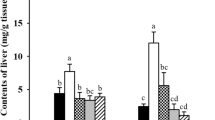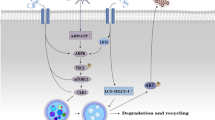Abstract
Background
Dietary sources of functional foods and nutraceuticals have demonstrated significant potential in treating of hypercholesterolemia and hypertension. Almond nuts (Terminalia catappa) and Orange (Citrus sinensis) peel have a long folklore history in the treatment of hypercholesterolemia and hypertension. This study aims to investigate the effects of almond and citrus peel formulated shortbread on lipid profile, oxidative stress and antioxidant parameters in high fat diet (HFD)/Nω-nitro-l-arginine methyl ester hydrochloride (L-NAME)- induced hyperlipidemic-hypertensive rats.
Methods
The experimental animals were distributed into eight groups and were orally administered L-NAME (40 mg/kg) and HFD. They were fed with varying amounts of almond and citrus peel formulated shortbread [0.2% citrus peel, 50% almond and combination of almond (50%)-citrus peel (0.2%). Thereafter, the effect of almond and citrus peel-formulated shortbread on the plasma lipid profile and antioxidant indices of the experimental rats were determined.
Results
The results showed a significant decrease in atherogenic index, total cholesterol, triglycerides, low-density lipoprotein (LDL), malondialdehyde (MDA) and reactive oxygen species in the rats fed with almond and citrus peel formulated shortbread compared to the HFD/L-NAME- induced rats. In addition, the almond and citrus peel formulated shortbread groups showed significant increase in the level of HDL cholesterol and activities of the superoxide dismutase and catalase of the induced rats.
Conclusions
The results showed that almond and citrus peel-formulated shortbread improved plasma lipid profile and antioxidant status in HFD/L-NAME- induced rats. Intriguingly, the almond (50%)-citrus (0.2%) formulated shortbread had the best antioxidative and antihyperlipidemic effects.











Similar content being viewed by others
Data availability
The data will be made available on request.
References
Alloubani A, Nimer R, Samara R. Relationship between hyperlipidemia, cardiovascular disease and stroke: a systematic review. Curr Cardiol Rev. 2021;17(6):52–66.
CDC. How and When to Have Your Cholesterol Checked | cdc. gov. Centers for Disease Control and Prevention. 2022. Published April 15, 2021. https://www.cdc.gov/cholesterol/checked.htm
Feng X, Zhang L, Xu S, Shen AZ. ATP-citrate lyase (ACLY) in lipid metabolism and atherosclerosis: An updated review. Prog lipid Res. 2020;2020(77):101006.
Morales-Villegas EC, Yarleque C, Almeida ML. Management of hypertension and dyslipidemia in Mexico: evidence, gaps, and approach. Arch Cardiol Méx. 2023;93(1):77–87.
Crismaru I, Pantea Stoian A, Bratun OG, Gaman MA, Stanescu AMA, Bacalbasa N, Diaconu CC. Low-density lipoprotein cholesterol lowering treatment: the current approach. Lipids Health Dis. 2020;2021(19):1–10.
Oguntibeju OO, Aboua Y, Goboza M. Vindoline—a natural product from Catharanthus roseus reduces hyperlipidemia and renal pathophysiology in experimental type 2 diabetes. Biomed. 2019;7(3):59.
Khutami C, Sumiwi SA, Khairul Ikram NK, Muchtaridi M. The effects of antioxidants from natural products on obesity, dyslipidemia, diabetes and their molecular signaling mechanism. Intl J Mol Sci. 2022;23(4):2056.
Lorenzon dos Santos J, Schaan de Quadros A, Weschenfelder C, Bueno Garofallo S, Marcadenti A. Oxidative stress biomarkers, nut-related antioxidants, and cardiovascular disease. Nutrition. 2020;12(3):682.
Miao J, Zang X, Cui X, Zhang J. Autophagy, hyperlipidemia, and atherosclerosis. Adv Exp Med Biol. 2020;1207:237–64.
Chukwu E, Osuocha KU, Iwueke AV. Phytochemical profiling, body weight effect and anti-hypercholesterolemia potentials of Cnidoscolus aconitifolius leaf extracts in male albino rat. J Pharmacog Phytother. 2020;12(2):19–27.
Memariani Z, Farzaei MH, Ali A, Momtaz S. Nutritional and bioactive characterization of unexplored food rich in phytonutrients. In: Nabavi SM, Suntar I et al., editors. Phytonutrients in Food. Cambridge: Woodhead Publishing; 2020. p 157–175.
Okhawa H, Ohishi N, Yagi K. Anal Biochem. 1979;95:351.
Alia M, Horcajo C, Bravo L, Goya L. Effect of grape antioxidant dietary fiber on the total antioxidant capacity and the activity of liver antioxidant enzymes induced by thermal oxidation of dietary lipids in rats. Nutrition. 2003;10:797–805.
Luck H. Catalase. In: Bergmeyer HU, editor. Method of Enzymatic Analysis. New York and London: Academic Press; 1965. p 885–894.
Rotruck JT, Pope AL, Ganther HE, Swanson AB, Hafeman DG, Hoekstra WG. Selenium: biochemical role as a component of glutathione peroxidase. Science. 1973;179:588–90.
Hayashi I, Morishita Y, Imai K, Nakamura M, Nakachi K, Hayashi T. High-throughput spectrophotometric assay of reactive oxygen species in serum. Mutat Res Genet Toxicol Environ Mutagen. 2007;1:55–61.
Bradford MM. A rapid and sensitive method for the quantitation of microgram quantities of protein utilizing the principle of protein-dye binding. Anal Biochem. 1976;7;72(1–2).
Dubey A, Dash SL, Kumari M, Patel S, Singh S, Agarwal S. A Comprehensive Review on Recent Progress in Invivo and Invitro Models for Hyperlipidemia Studies. Pak Heart J. 2023;56(1):286–97.
Singh A. Hyperlipidemia in cardiovascular health and digestion. In: Debasis B, Ohia SE, editor. Nutrition and Functional Foods in Boosting Digestion, Metabolism and Immune Health. New York and London: Academic Press; 2022. p. 141–150.
Ji E, Lee S. Antibody-based therapeutics for atherosclerosis and cardiovascular diseases. Intl J Mol Sci. 2021;22(11):5770.
Khatana C, Saini NK, Chakrabarti S, Saini V, Sharma A, Saini RV, Saini AK. Mechanistic insights into the oxidized low-density lipoprotein-induced atherosclerosis. Oxid Med Cell Longev. 2020. https://doi.org/10.1155/2020/5245308.
Ramchoun M, Khouya T, Harnafi H, Alem C, Benlyas M, Simmet T, Amrani S. Effect of polyphenol, flavonoid, and saponin fractions from Thymus atlanticus on acute and chronic hyperlipidemia in mice. Future J Pharm Sci. 2020;6(1):1–9.
Arnold SV, De Lemos JA, Rosenson RS, Ballantyne CM, Liu Y, Mues KE, GOULD Investigators. Use of guideline-recommended risk reduction strategies among patients with diabetes and atherosclerotic cardiovascular disease: insights from Getting to an Improved Understanding of Low-Density Lipoprotein Cholesterol and Dyslipidemia Management (GOULD). Circulation. 2019;140(7):618–620.
Su L, Mittal R, Ramgobin D, Jain R, Jain R. Current management guidelines on hyperlipidemia: the silent killer. J Lipids. 2021. https://doi.org/10.1155/2021/9883352.
Stein R, Ferrari F, Scolari F. Genetics, dyslipidemia, and cardiovascular disease: new insights. Curr Cardiol Rep. 2019;21:1–12.
Mardi P, Abdi F, Ehsani A, Seif E, Djalalinia S, Heshmati J, Qorbani M. Is non-high-density lipoprotein associated with metabolic syndrome? A systematic review and meta-analysis. Front Endocrinol. 2022;13:957136.
Guo L, Xiao J, Liu H, Liu H. Selenium nanoparticles alleviate hyperlipidemia and vascular injury in ApoE-deficient mice by regulating cholesterol metabolism and reducing oxidative stress. Metallomics. 2020;12(2):204–17.
Makhdoumi P, Karimi H, Khazaei M. Review on metal-based nanoparticles: role of reactive oxygen species in renal toxicity. Chem ResToxicol. 2020;33(10):2503–14.
Ling Y, Shi Z, Yang X, Cai Z, Wang L, Wu X, Jiang J. Hypolipidemic effect of pure total flavonoids from peel of Citrus (PTFC) on hamsters of hyperlipidemia and its potential mechanism. Exp Gerontol. 2020;130:110–786.
Adedapo KS, Adepoju S, Olusanya TO. Effects of selected antioxidants on atherosclerosis in hyperlipidemic wistar rats. Asian J Med Health. 2019;16(4):1–8.
Olorunnisola OS, Adegbola PI, Ajilore BS, Akintola OA, Fadahunsi OS. The role of poly-herbal extract in sodium chloride-induced oxidative stress and hyperlipidemia in male wistar rats. Medicine. 2021;8(6):25.
Ramos LPA, Justino AB, Tavernelli N, Saraiva AL, Franco RR, de Souza AV, Espindola FS. Antioxidant compounds from Annona crassiflora fruit peel reduce lipid levels and oxidative damage and maintain the glutathione defense in hepatic tissue of Triton WR-1339-induced hyperlipidemic mice. Biomed Pharmacother. 2021;2021(142):112049.
Byrne NJ, Rajasekaran NS, Abel ED, Bugger H. Therapeutic potential of targeting oxidative stress in diabetic cardiomyopathy. Free Rad Biol Med. 2021;169:317–42.
Acknowledgements
The authors would like to thank the Functional Foods and Nutraceutical Unit, Department of Biochemistry for the facilities provided during the present study.
Author information
Authors and Affiliations
Contributions
AA conceived the research work; AO and OO supervised the project and gave the required tips and scientific instructions. The article was prepared by OO. All authors read and approved the final manuscript.
Corresponding author
Ethics declarations
Ethics approval and Consent to participate
Not applicable.
Consent for publication
Not applicable.
Competing interests
The authors declare that they have no competing interests.
Rights and permissions
Springer Nature or its licensor (e.g. a society or other partner) holds exclusive rights to this article under a publishing agreement with the author(s) or other rightsholder(s); author self-archiving of the accepted manuscript version of this article is solely governed by the terms of such publishing agreement and applicable law.
About this article
Cite this article
Ademosun, A.O., Ojueromi, O.O. & Oboh, G. Almond-citrus peel formulated shortbread modulates plasma lipid profile and oxidative status in hyperlipidemic hypertensive rats. Nutrire 48, 46 (2023). https://doi.org/10.1186/s41110-023-00233-8
Received:
Accepted:
Published:
DOI: https://doi.org/10.1186/s41110-023-00233-8




